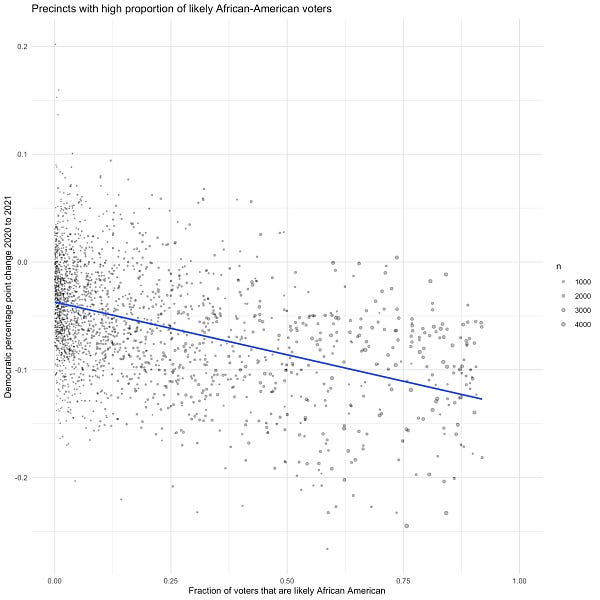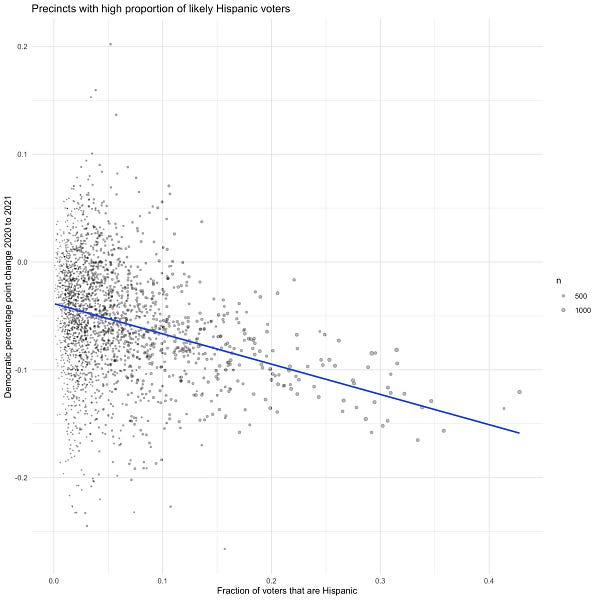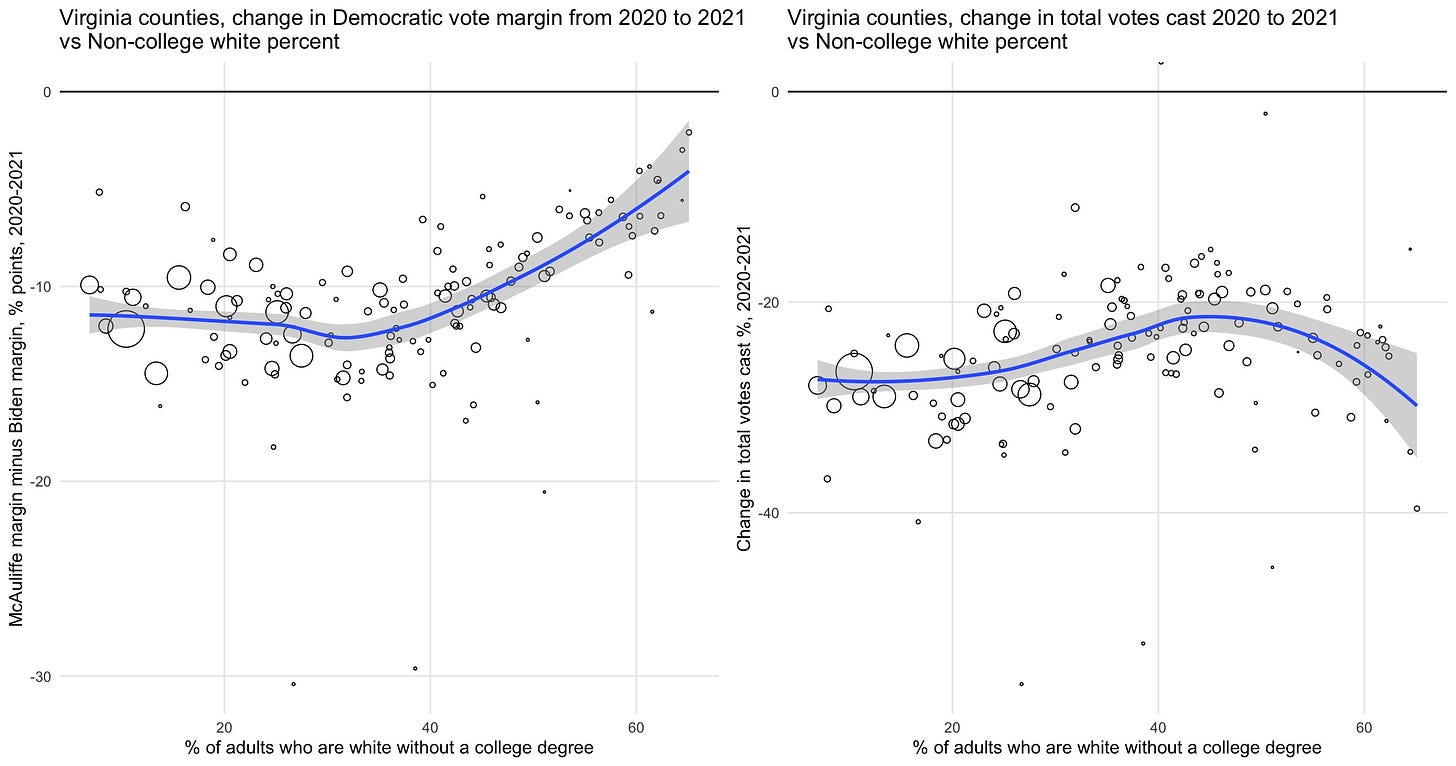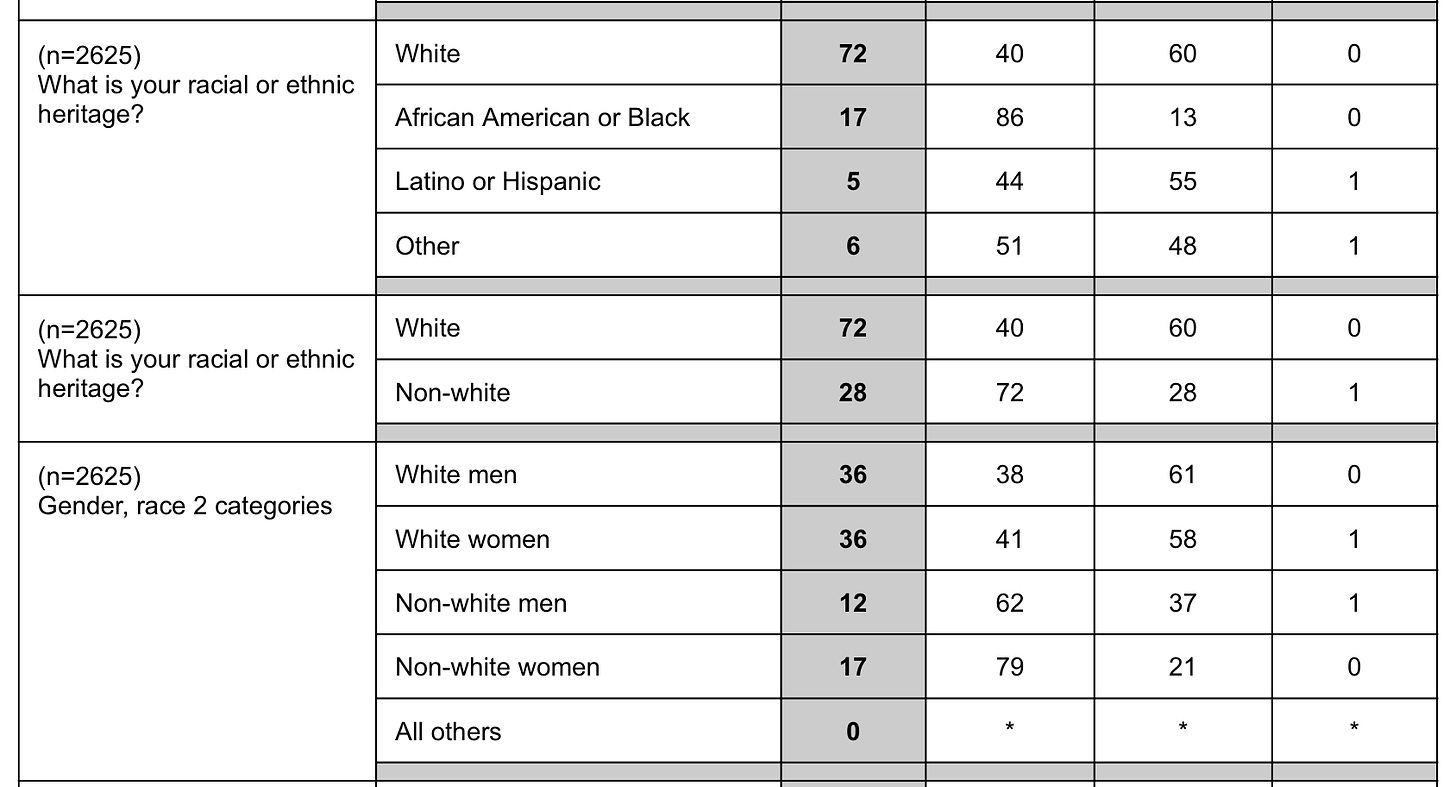Exit polls tell conflicting stories of the 2021 Virginia governor's race
Neither the claims that Republicans won Hispanics nor that college-educated whites stayed in place seem correct
Knowing the political composition of different demographic groups is key to political journalism, campaign strategy, and our collective understanding of the body politic. That’s why problems with the exit polls in Virginia — where Democrat Terry McAuliffe just lost the governors’ election to Glenn Youngkin — should trouble you.
Take for example the exit polls from Edison Research (conducted on behalf of the major news networks). They show that Democrats made gains with Latino and Asian voters between 2020 and 2021 despite their declining vote share statewide. According to Edison, Youngkin won in Virginia because McAuliffe’s share of the two-party vote with whites fell by eight points relative to Biden’s share with the group last year.
This is not unbelievable in isolation. Eg, perhaps Latino voters were just particularly drawn to Trump last year, and so have now reverted to their typical Democratic lean. However, this is a weird result when you consider that it is rare for a party to improve significantly with a group when their overall vote share falls by six points over a year. Usually, the public moves in more parallel strides. (NB: There is more heterogeneity on longer time horizons, to be sure.)
The Edison exit poll starts looking a lot stranger once we look at swings among white voters by their education level. According to Edison, McAuliffe won just 24% of white voters without degrees. That’s compared to Joe Biden’s 38% just a year ago — making for a 14-point decline. And according to their exits, college-educated whites and voters of color did not change significantly since 2020:
OK, now things are starting to fail the smell test. Maybe you believe non-college-educated whites moved right since 2020. That is a reasonable assumption; Biden is less popular than he was a year ago and, after all, Democrats did lose the election! But do we really believe that the only group to change its political leaning since 2020 was whites without degrees? In an election where overall Democratic margin fell by ten points? That explanation falls flat even before we look at other evidence.
But if we do, the county and precinct-level results of the election are pretty damning of the exits. The two charts below show that Terry McAuliffe’s share of the vote fell by less relative to Joe Biden’s share of the vote in the counties with the highest percentages of non-college whites. Turnout was also down the least in places with a middling share of non-college whites.
How is this reconcilable with the exit poll? The short answer is that it’s not. While it is technically possible that white college-educated voters in counties with a lot of non-college whites are driving the trends in the figures above, that wouldn’t explain the full relationship. Besides, according to Edison, college-educated whites didn’t change their behavior at all since 2020! And there aren’t enough non-whites in these counties to drive significant trends either; the exits estimate voters of color made up just over a fourth of Virginian voters in 2021, and there are fewer of them in the counties with the highest shares of non-college whites.
As if this weren’t enough, friend of the blog Lenny Bronner (who runs the elections-forecasting models for the Washington Post) found that McAuliffe did worse versus Biden in the precincts with the most African Americans and Hispanics. This is a direct contradiction of the exit poll!



So, if we can’t trust the Edison exit poll, how can we understand what happened in the election?
Fear not! For the Associated Press has partnered for several years with the National Opinion Research Center at the University of Chicago to produce an alternative exit poll. It consists of a combination of pre-election surveys fielded over the web and via phone which is then weighted to match the topline results of the election. Their estimates get published by Fox and mostly look a lot more reasonable than Edison’s:
Except… wait, what’s this? The poll says McAuliffe lost Hispanics by 11 percentage points — which would be a nearly 40 point swing on margin (18 on vote share) since the 2020 election! Again, the smell test is suggesting something is really wrong here.
Maybe that “something” is sampling error. The exit polls from AP-NORC and Edison surveyed only about 100 Latino voters (and even fewer Black Virginians), and they could have been unrepresentative of the population of Hispanics in reality. Or maybe something is going on in the weighting algorithms; when pollsters adjust their data to match the results of the election, sometimes their programs move groups around in unpredictable ways in order to balance out the survey. But we really can’t say for sure what’s going on — or, for that matter what the truth is.
So what is an analyst to do? Well, you could simply combine the exits. The law of large numbers postulates that larger sample sizes should converge around the truth eventually. Two exit polls are thus better than one. And, yeah, the results here look a lot more reasonable:
Yet the county and precinct results still show that Democratic dropoff was more severe in areas with more non-college whites. The combined exit polls suggest the opposite.
The only thing I can confidently conclude from this is that we can’t really trust these exits. If you do choose to look at them, at the very least, you should be careful when people use the exits to make arguments that just so happen to confirm all of their priors and ideological beliefs:
The big takeaway: When it comes to assessing the composition of the electorate using exit polls, there is no truth; There are only estimates.










